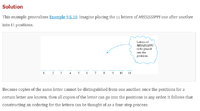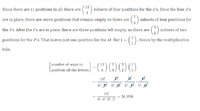I'm working on some inclusion/exclusion problems and I'm not sure what to do here. I followed some other examples but I'm not getting the correct answer.
Consider reordering the letters in the word TENNESSEE. Use the technique shown in Example 9.5.11 to answer the following questions.
If the N's are placed first, how many ways are there to choose positions for them?
My solution:
n = 8 by combing the Ns into one and subtracting that from the total 9 letters
n1 = 1 because there is one N (combined)
n2 = 2 because there are two S
n3 = 4 because there is four E
n4 = 1 because there is one T
8! /( 1! * 2! * 4! * 1! ) = 40320 / 48 = 840.......Those parentheses are important
840 isnt the answer. Not sure what I'm doing wrong here...any suggestions?
Consider reordering the letters in the word TENNESSEE. Use the technique shown in Example 9.5.11 to answer the following questions.
If the N's are placed first, how many ways are there to choose positions for them?
My solution:
n = 8 by combing the Ns into one and subtracting that from the total 9 letters
n1 = 1 because there is one N (combined)
n2 = 2 because there are two S
n3 = 4 because there is four E
n4 = 1 because there is one T
8! /( 1! * 2! * 4! * 1! ) = 40320 / 48 = 840.......Those parentheses are important
840 isnt the answer. Not sure what I'm doing wrong here...any suggestions?
Last edited by a moderator:


